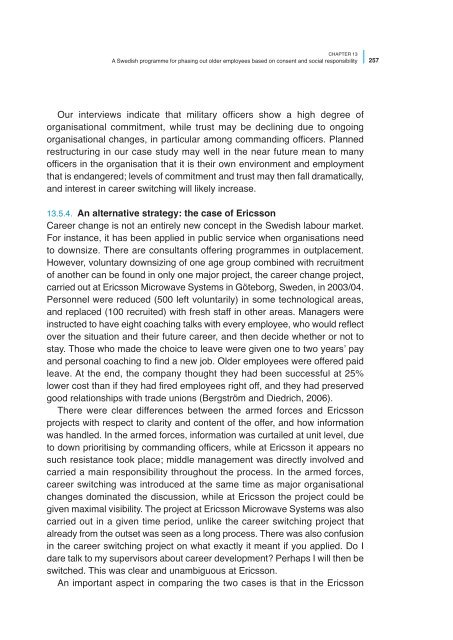Working and ageing - Cedefop - Europa
Working and ageing - Cedefop - Europa
Working and ageing - Cedefop - Europa
Create successful ePaper yourself
Turn your PDF publications into a flip-book with our unique Google optimized e-Paper software.
CHAPTER 13<br />
A Swedish programme for phasing out older employees based on consent <strong>and</strong> social responsibility 257<br />
Our interviews indicate that military officers show a high degree of<br />
organisational commitment, while trust may be declining due to ongoing<br />
organisational changes, in particular among comm<strong>and</strong>ing officers. Planned<br />
restructuring in our case study may well in the near future mean to many<br />
officers in the organisation that it is their own environment <strong>and</strong> employment<br />
that is endangered; levels of commitment <strong>and</strong> trust may then fall dramatically,<br />
<strong>and</strong> interest in career switching will likely increase.<br />
13.5.4. An alternative strategy: the case of Ericsson<br />
Career change is not an entirely new concept in the Swedish labour market.<br />
For instance, it has been applied in public service when organisations need<br />
to downsize. There are consultants offering programmes in outplacement.<br />
However, voluntary downsizing of one age group combined with recruitment<br />
of another can be found in only one major project, the career change project,<br />
carried out at Ericsson Microwave Systems in Göteborg, Sweden, in 2003/04.<br />
Personnel were reduced (500 left voluntarily) in some technological areas,<br />
<strong>and</strong> replaced (100 recruited) with fresh staff in other areas. Managers were<br />
instructed to have eight coaching talks with every employee, who would reflect<br />
over the situation <strong>and</strong> their future career, <strong>and</strong> then decide whether or not to<br />
stay. Those who made the choice to leave were given one to two yearsʼ pay<br />
<strong>and</strong> personal coaching to find a new job. Older employees were offered paid<br />
leave. At the end, the company thought they had been successful at 25%<br />
lower cost than if they had fired employees right off, <strong>and</strong> they had preserved<br />
good relationships with trade unions (Bergström <strong>and</strong> Diedrich, 2006).<br />
There were clear differences between the armed forces <strong>and</strong> Ericsson<br />
projects with respect to clarity <strong>and</strong> content of the offer, <strong>and</strong> how information<br />
was h<strong>and</strong>led. In the armed forces, information was curtailed at unit level, due<br />
to down prioritising by comm<strong>and</strong>ing officers, while at Ericsson it appears no<br />
such resistance took place; middle management was directly involved <strong>and</strong><br />
carried a main responsibility throughout the process. In the armed forces,<br />
career switching was introduced at the same time as major organisational<br />
changes dominated the discussion, while at Ericsson the project could be<br />
given maximal visibility. The project at Ericsson Microwave Systems was also<br />
carried out in a given time period, unlike the career switching project that<br />
already from the outset was seen as a long process. There was also confusion<br />
in the career switching project on what exactly it meant if you applied. Do I<br />
dare talk to my supervisors about career development? Perhaps I will then be<br />
switched. This was clear <strong>and</strong> unambiguous at Ericsson.<br />
An important aspect in comparing the two cases is that in the Ericsson

















